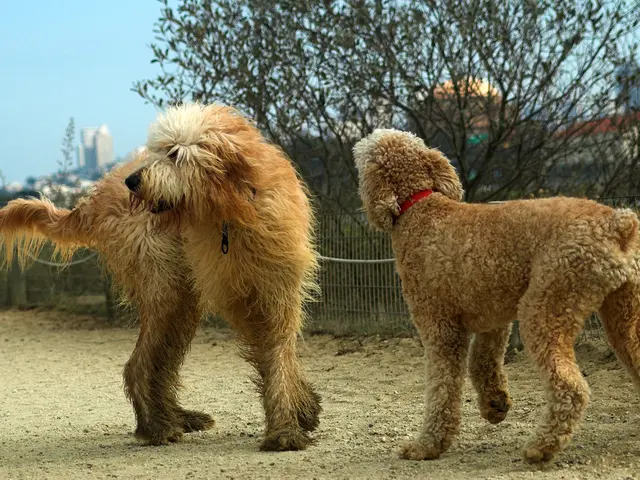7 outstandingly appealing dog breeds that naturally lack fur:
Discover the joy of owning a hairless canine companion if you're all about maintaining a tidy home without the hassle of fur! Although these breeds might seem like a low-maintenance choice, they still need as much attention as their more furry counterparts.
While their lack of hair can reduce allergy symptoms compared to other breeds, they still produce dander and saliva that could cause problems for those with dog allergies. However, many find their symptoms to be less severe due to lesser fur exposure.
These unusual pups will undoubtedly make heads turn with their unique appearances. Hairless breeds come in various shapes and sizes, carrying genes that cause them to be either hairless or have minimal fur on their bodies. These fur-free friends are known for their cuddly nature and enjoy cozying up with their lucky owners.
If you're looking to add a hairless breed to your family, here are seven options that might catch your eye:
- American Hairless Terrier - Cute and curious, this Louisiana native stands between 12-16 inches tall. Originally bred for rat hunting, they now excel at agility and obedience competitions. They make great exercise companions, being alert, smart, inquisitive, and playful. They're also well-known for their affectionate and social nature.
- Chinese Crested - One of the most unique breeds out there, the Chinese Crested stands between 11-13 inches tall, sporting spotted pink skin, a spiky hairdo, furry socks, and a feathery tail. Fine-boned and graceful, they're incredibly playful and loving, making wonderful companions.
- Peruvian Inca Orchid - Thought to have originated as early as 750 AD, this ancient breed is known for its smooth, close-fitting skin. They come in various sizes, with the smallest standing at just under 10 inches tall and the largest reaching 26 inches. Playful and affectionate, they are very sweet-tempered dogs.
- Mexican Hairless Dog (Xoloitzcuintli) - One of the oldest dog breeds in the world, dating back more than 3,000 years, this breed has been a part of the Aztec empire. They are intelligent, loyal, and adaptable dogs, though they can be stubborn and headstrong, so early training and socialization are essential.
- Argentine Pila Dog - Found mostly in Argentina, this rare breed is highly adaptable and settles easily into various environments. Affectionate, playful, and alert, they make excellent watchdogs. They come in three sizes, between 10-25 inches tall, with a curling tail and pointed ears.
- Hairless Khala - Native to Bolivia, the Hairless Khala comes in two types: Medio (14-17 inches tall) and Grande (17-20 inches tall). They tend to be affectionate, docile with family, but aloof and standoffish with strangers. Early training and socialization are crucial for these fiercely protective dogs.
- Abyssinian Sand Terrier - Also known as African Hairless Dogs, these curious critters may be mythical as there is no known evidence of their current existence apart from a specimen in the Natural History Museum in Hertfordshire, England. They are semi-wild dogs that follow African cattle herders, and unfortunately, it is highly unlikely you can own one.
Remember, hairless dog breeds require special care due to their sensitive skin and lack of fur. Here are some essential care tips to help make your hairless pooch comfortable and healthy:
- Sun Protection: Hairless dogs are at risk of sunburn and skin cancer; protect them from UV rays by keeping them indoors during the strongest UV hours and applying sunscreen. Consider dressing them in a T-shirt or vest during the summer.
- Grooming: While they don't have fur, they still need regular bathing (every 1-2 weeks) to remove excess oils, debris, and to prevent acne. Using a mild, dog-specific shampoo is crucial. An occasional mild exfoliation may help prevent blackheads and spots, and antibacterial shampoo may be necessary if they are prone to skin infections.
- Skin Care: Hairless dogs' skin can dry out in cold or indoor temperatures, so apply moisturizer regularly to keep their skin soft, flexible, and hydrated.
- Temperature Sensitivity: These dogs are sensitive to temperature changes, so layer them up with warm clothes during the winter months, and continue moisturizing to help keep their skin hydrated in dry or heated environments.
- Nail Care: Hairless dog nails grow faster than other breeds, so keep a close eye on their nails and trim them as needed to prevent injury and discomfort.
These precautions and lifestyle adjustments will help ensure the comfort and health of your hairless fur baby! If you're ready for a new addition to your family, consider one of these unique and lovable hairless breeds.
- The American Hairless Terrier, standing between 12-16 inches tall, is a lively addition to any home, excelling in agility and obedience competitions, and being affectionate and social.
- The Chinese Crested, reaching 11-13 inches in height, is a unique breed with spots on its pink skin, spiky hair on its head, furry socks, and a feathery tail, known for its playful and loving nature.
- The Peruvian Inca Orchid, known for its smooth, close-fitting skin, comes in various sizes and is playful, affectionate, and sweet-tempered.
- The Mexican Hairless Dog (Xoloitzcuintli), dating back more than 3,000 years, is an intelligent, loyal, and adaptable dog, though early training and socialization are essential due to its stubbornness.
- The Argentine Pila Dog, ranging from 10-25 inches in height, is affectionate, playful, and alert, making excellent watchdogs.
- The Hairless Khala, originating from Bolivia, is affectionate, docile with family, but aloof and standoffish with strangers, requiring early training and socialization for its fierce protective nature.
- The Abyssinian Sand Terrier, also known as African Hairless Dogs, may be mythical and unlikely to own, but if found, they are curious creatures that follow African cattle herders.
In addition to providing love and companionship, hairless dog breeds require special care due to their sensitive skin and lack of fur. This includes sun protection, regular grooming, skin care, temperature sensitivity, nail care, and nutritional considerations for a balanced lifestyle and overall pet health.







